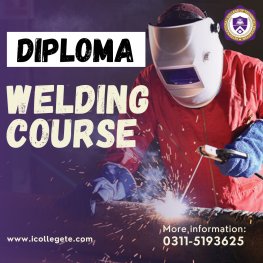
Address
Office # 27, Second Floor, Maryam Shadi Hall Plaza (Airies Plaza), Shamsabad, Murree Road, Rawalpindi, Pakistan View mapCourse Overview:
Welding, often hailed as the art of joining metals through the process of fusion, has been a fundamental skill shaping various industries. The demand for skilled welders continues to rise, making welding courses an invaluable resource for those seeking to enter this dynamic field.
Course Benefits:
Embarking on a welding course offers a myriad of benefits, both professionally and personally. From gaining hands-on experience in a versatile skill set to increasing employability in diverse industries, the advantages are significant. Welders are in constant demand in construction, manufacturing, and infrastructure development, ensuring a stable career path. Additionally, the ability to work on projects of varying scales provides a sense of accomplishment and pride.
Learning Outcomes:
The core learning outcomes of a welding course extend beyond just mastering the technicalities of welding. Participants develop a profound understanding of safety protocols, welding techniques, and material properties. They also cultivate problem-solving skills and attention to detail, essential attributes in the field. The hands-on nature of welding courses ensures that students are well-prepared for real-world challenges, creating a strong foundation for a successful career.
Study Units:
Welding courses typically cover a range of study units designed to provide a holistic understanding of the craft. Key areas include:
- Welding Fundamentals: An introduction to the basic principles of welding, covering various methods such as MIG, TIG, and stick welding.
- Safety Protocols: Comprehensive training on safety measures, protective gear, and best practices to ensure a secure work environment.
- Material Science: Understanding the properties of different metals and alloys, allowing welders to make informed decisions based on the material being used.
- Blueprint Reading: Interpreting and understanding engineering drawings and blueprints to execute precise welds as per specifications.
- Welding Inspection: Training in quality control and inspection processes to maintain high standards in the final product.
Who is this Course For?
A welding course is suitable for a diverse range of individuals, including:
- Career Starters: Those looking to kickstart a fulfilling career in welding.
- Industry Professionals: Individuals already working in related fields seeking to enhance their skill set.
- DIY Enthusiasts: Hobbyists and DIY enthusiasts keen on mastering welding for personal projects.
Future Progression:
The prospects for individuals completing a welding course are promising. Graduates can explore various paths, including:
- Welding Technician: Working hands-on to create and repair metal structures.
- Welding Inspector: Ensuring quality and compliance with industry standards.
- Fabrication Specialist: Crafting metal components for construction and manufacturing.
- Entrepreneurship: Establishing one’s welding business, catering to the needs of local communities.
In conclusion, a welding course serves as the gateway to a fulfilling and dynamic career. Whether you’re a career starter, industry professional, or a DIY enthusiast, the skills acquired through a welding course are bound to open doors to a world of opportunities in the welding industry. So, gear up, put on your welding helmet, and let the sparks of your future fly high!

